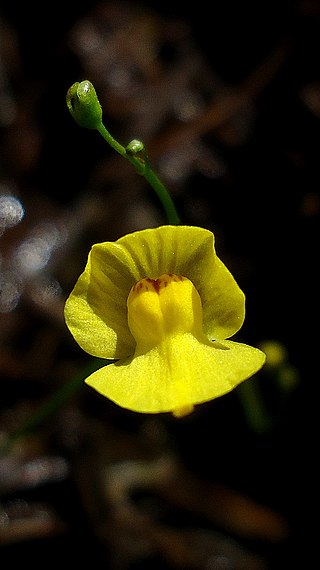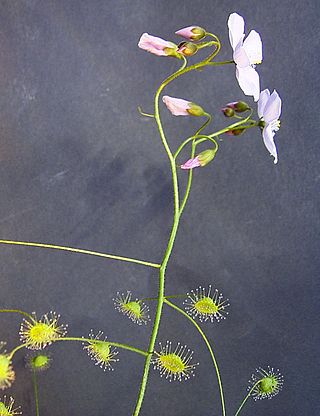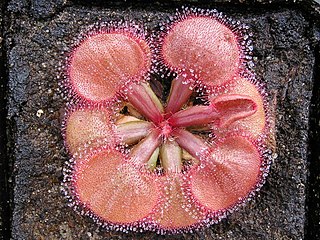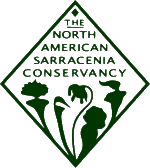
Drosera adelae, commonly known as the lance-leaved sundew, is a carnivorous plant in the genus Drosera that is endemic to Queensland, Australia.

Adrian Slack was a landscape gardener, plantsman, author and authority on carnivorous plants. He won 5 gold medals at the Chelsea Flower Show, and authored two books: Carnivorous Plants and Insect-Eating Plants and How to Grow Them.

The Carnivorous Plant Newsletter is the official publication of the International Carnivorous Plant Society (ICPS), the largest such organization in the world. It is headquartered in Walnut Creek, California.

Drosera binata, commonly known as the forked sundew or fork-leaved sundew. It is a large, perennial sundew native to Australia and New Zealand. The specific epithet is Latin for "having pairs" - a reference to the leaves, which are dichotomously divided or forked.

Sarracenia alata, also known as yellow trumpets, pale pitcher plant or pale trumpet, is a carnivorous plant in the genus Sarracenia. Specifically, S. alata is an endemic species to North America; it is native to the southeastern regions of the United States, including parts of the Gulf Coast states.

Utricularia gibba, commonly known as the humped bladderwort or floating bladderwort, is a small, mat-forming species of carnivorous aquatic bladderwort. It is found on all continents except Antarctica.
Peter Geoffrey Taylor (1926–2011) was a British botanist who worked at Royal Botanic Gardens, Kew throughout his career in botany. Taylor was born in 1926 and joined the staff of the herbarium at Kew in 1948. He published his first new species, Utricularia pentadactyla, in 1954. In 1973, Taylor was appointed curator of the orchid division of the herbarium and, according to Kew, "under his direction, orchid taxonomy was revitalised and its horticultural contacts strengthened."

Drosera slackii is a subtropical sundew native to the Cape Provinces of South Africa. It forms rosettes that range from to two to four inches in diameter, and produces pink flowers. It is named after the British plantsman and author Adrian Slack (1933-2018).

Peter D'Amato was an American author, businessman, and carnivorous plant authority. He was the owner of California Carnivores, located in Sebastopol, possibly the largest nursery of carnivorous plants in the world, and the author of The Savage Garden, a book on the cultivation of insectivorous plants. His book won the American Horticultural Society Book Award and the Quill & Trowel Award from the Garden Writers Association of America, both in 1999.

Drosera gigantea, the giant sundew, is an erect perennial tuberous species in the carnivorous plant genus Drosera that is endemic to Western Australia. It grows in sandy soils at the margins of swamps and near granite outcrops along the Western Australian coast from Albany north to just south of Geraldton. D. gigantea produces small shield-shaped leaves along many lateral branches that look like a small tree. Individual plants can grow up to 0.2–1 m (0.7–3.3 ft) tall. Because of its tall, tree-like form, it is considered one of the largest Drosera species. It is also easily cultivated and enjoys damp, humid conditions often provided in greenhouses. White flowers emerge from August to November. The red tubers of this species can grow to be 3.8 cm (1.5 in) in diameter and may be a metre below ground.

Drosera macrantha, the bridal rainbow, is a scrambling or climbing perennial tuberous species in the carnivorous plant genus Drosera that is endemic to Western Australia. It grows in a variety of habitats, including winter-wet depressions in sandy, loamy, laterite, or quartzite soils. D. macrantha produces small, cup-shaped carnivorous leaves along a long stem that can be 0.16–1.5 m (0.5–4.9 ft) high as it climbs. Its 1 in (2.5 cm) white or pink flowers emerge from June to November, blooming earlier in the more northern range.
Drosera marchantii is an erect perennial tuberous species in the carnivorous plant genus Drosera. It is endemic to Western Australia and grows in a variety of habitats, including swampy areas and hilltops in laterite-silica sand soils. D. marchantii produces small, circular, peltate carnivorous leaves along stiff stems that can be 10–40 cm (4–16 in) high. Its pink flowers emerge from June to October.

Drosera microphylla, the golden rainbow, is an erect perennial tuberous species in the carnivorous plant genus Drosera. It is endemic to Western Australia and grows on granite outcrops or in sandy or laterite soils. D. microphylla produces small, circular, peltate carnivorous leaves along erect stems that can be 10–40 cm (4–16 in) high. It blooms from June to September, displaying its large golden sepals and smaller, variably-coloured petals. In populations near Perth, the petals are red, whereas petal colour near Albany tends to be orange. Some plants east of Esperance have white petals.
Drosera modesta, the modest rainbow, is a scrambling perennial tuberous species in the carnivorous plant genus Drosera. It is endemic to Western Australia and grows on granite outcrops or stream banks in laterite or sand-clay soils. D. modesta produces shield-shaped carnivorous leaves with longer than normal tentacles. The scrambling stems can be 0.3–0.8 m (1.0–2.6 ft) long. White flowers bloom from October to November.
Drosera moorei is a scrambling or climbing perennial tuberous species in the carnivorous plant genus Drosera. It is endemic to Western Australia and grows near granite outcrops in sandy loam. D. moorei produces small, circular, peltate carnivorous leaves along glabrous stems that can be 12–35 cm (5–14 in) long. Inflorescences have two to ten yellow flowers and bloom from September to October.

Drosera falconeri is a carnivorous plant in the family of Droseraceae. It is endemic to the Northern Territory of Australia.

The Carnivorous Plants is a major work on carnivorous plants by American botanist Francis Ernest Lloyd. It was first published in 1942 by the Chronica Botanica Company as the ninth volume of A New Series of Plant Science Books. It was reprinted in 1976 by Dover Publications of New York and Constable of London. Although primarily dealing with plants, the book also briefly covers carnivorous fungi. The chapter describing the structure and functioning of Utricularia traps is particularly detailed. Lloyd's book was the most important scientific work on carnivorous plants since Charles Darwin's Insectivorous Plants of 1875.

The North American Sarracenia Conservancy (NASC) is a 501(c)(3) non-profit organization dedicated to habitat conservation. Founded in 2005, the Conservancy was granted tax-exempt status in January 2009. The main focus of the Conservancy is the conservation and preservation of the natural habitats and genetic diversity of the Sarracenia pitcher plants. Sarracenia is a genus of carnivorous plant that trap prey in tube-shaped, hollow leaves, which in some species hold rain water. Species range from the southeastern United States, up the coastal plain, and into the Great Lakes and Canada. Within their range the plants naturally occur in sphagnum bogs, swamps, fens, and flooded plains.

California Carnivores is a plant nursery in Sebastopol, California in the United States. Specializing in the cultivation of carnivorous plants, CC is home to one of the largest collections of imported carnivorous plants in North America, and possibly the world, with more than 1,000 types of imported plant and dozen of varieties for sale in the retail section of the nursery.
Savage Garden was an Australian rock band.















